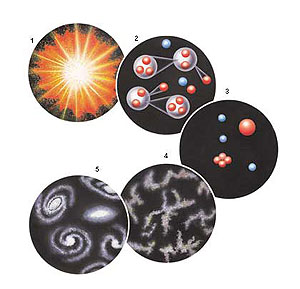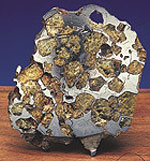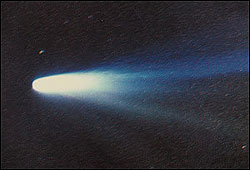The search for life: Astrobiology
By Monica Grady
The Big Bang
We begin with the Big Bang, the origin of time and space, when all matter and energy were created. It occurred approximately 15 billion years ago when a point with unimaginable temperature, pressure and density exploded. Within about a minute of the Big Bang the universe had expanded by a million times, and it is still expanding today. After 2 billion years matter started to clump together to form the first galaxies and stars. After a further 8 billion years, the sun and planets of our solar system came into being. In this session we'll cover the formation of the solar system, asteroids, meteorites, comets and why the Earth is particularly special in this system.

1. Time: 0
Matter and energy are created in the Big Bang.
2. Time: 60 secs
Temperature: 1 billion °C.
Protons and neutrons join together to make nuclei, the central cores of atoms.
3. Time: 300,000 years
Temperature: 3000°C.
Electrons combine with nuclei to produce atoms of hydrogen and helium.
4. Time: 1 billion years
Temperature: -250°C.
Matter clumps together to form galaxies, where stars form.
5. Time: 10 billion years
Temperature: -270°C.
The sun and planets form.
The formation of the solar system
Located two-thirds of the way out of the centre of the Milky Way galaxy, the sun is sometimes described as an undistinguished star in an undistinguished neighbourhood. It is surrounded by a family of planets and their satellites, plus asteroids and comets.
Matter drifts through space as clouds of gas and dust; the first stage in the formation of the solar system was the collapse of one of these interstellar clouds. This created a 'protoplanetary disk'--the solar nebula. Astronomers have suggested that the cloud collapse was triggered by a shockwave from a nearby supernova (the sudden, rapid explosion of a star). Dustgrains, falling towards the centre of the nebula clumped together, eventually formed planets, their growth controlled by factors such as the nature of the grains and the degree of turbulence within the nebula. The collapse of the cloud and subsequent accretion of material took place over a short time interval of 1 to 3 million years.
Asteroids

Asteroid 433 Eros, photographed from an altitude of 200 kilometres in February 2000. It is a stony asteroid, 33 km long by 13 km wide. © NASA/JPL/Caltech.
The Asteroid Belt, a swarm of several thousand small rocky planets (planetesimals), marks the boundary between the rocky planets (Mercury, Venus, Earth and Mars) and the outer gas giants (Jupiter, Saturn, Uranus and Neptune). Asteroids are the leftovers from the planet-building process. Although the largest, Ceres, is around 1000km across, the majority measure only several kilometres across. They are grouped into types based on composition: some are predominantly composed of iron or stone whilst others are rich in carbon.
Their cratered surfaces are evidence of collisions with other asteroids, often outside their stable orbits around the sun. Fragments ejected from the Asteroid Belt may fall onto the inner planets--on Earth, these are known as meteorites.
Almost all meteorites (pieces of rock and metal that fall to Earth) are fragments from asteroids. The study of meteorites permits a more complete understanding of the materials--the organic dust--that formed the Earth, and how they changed through time. There are two main types: melted and unmelted meteorites (chondrites).
Melted meteorites: Melted meteorites come from asteroids that were so hot they melted. They are slightly younger than the chondrites and comprised of iron, stone or a combination of both. The study of melted meteorites can help explain the processes involved in the formation of planets and planet cores.

A polished piece of pallasite (stony-iron meteorite), about eight cm across.
Chondrites: Chondrites are the most primitive meteorites. They are made from the same dust that made the Earth but the composition of their parent asteroids has changed only slightly since their formation early in the history of the solar system. They are therefore direct ancestors of the Earth and are studied to gain a better understanding of how the Earth has evolved to its present state. Chondrites are stone meteorites and contain calcium and aluminium-rich inclusions (CAIs), which are the oldest of all planetary materials, formed very soon after the initial collapse of the solar nebula. They also contain chondrules, tiny, millimetre-sized spherical formations, which along with the CAIs provide information about the Earth's formation. The presence of carbon (mainly in organic compounds) in some meteorites is direct evidence that asteroidal material might have contributed the ingredients for life on Earth during bombardment.
Comets

Halley's Comet as it appeared in February 1986. The bluer of the two tails (uppermost) is made up of gases, whilst the lower tail, illuminated by reflected sunlight, is the dust tail. © Anglo-Australian Observatory/Royal Observatory, Edinburgh, Photograph from UK Schmidt plates by David Malin
Comets are compact collections of silicate dust and ices containing organic compounds, made during the final stages of the formation of the solar system. They are neither heated nor melted, and therefore represent the most primordial material available for study. Comets form at the outermost reaches of the solar system, a region known as the Oort Cloud. They usually remain in stable orbits within the Oort Cloud but are occasionally ejected further in and begin to orbit the sun. When a comet approaches the sun a dust tail is formed as ices vaporise and dust grains are swept backwards. Halley's Comet is one of the most well-known; its nucleus measures only 16x8 kilometres but its tail stretches back for hundreds of thousands of kilometres.
Some of the dust grains eventually land on Earth, and in this way, comets played a vital role in the development of life. The dust contains water and organic compounds so it is possible that comets could also have played a crucial part in the development of life forms on other planets, including Mars.
Halley's Comet
The first reported sightings of Halley's Comet were by Chinese astronomers in 240 BC. The comet appears about every 76 years and was named after Sir Edmond Halley, an English astronomer who studied the paths of comets in the seventeenth century. In the past, comets couldn't be scientifically explained and were thought to be bad omens--people feared them as harbingers of death, defeat, hunger and disease. Halley's Comet appears in the Bayeux Tapestry, which tells the story of the defeat of the Saxon king Harold by William of Normandy in 1066. The comet appears close to the figure of Harold, seated on a throne and wearing a crown. Six months after the comet appeared on April 24th 1066, Harold was killed by an arrow through his eye and England fell to the French.
What makes the Earth so special?
The Earth has many special features that set it apart from the other planets within the solar system, features which are seen as the reason for the formation of life. These are outlined below:
The Habitable Zone: The Earth is the only planet located in the Habitable Zone of the solar system. Here, temperatures and pressures are such that liquid water is stable at the planetary surface. This is predicted to change in the future however, as the sun has been getting hotter over its 4.56 billion-year lifetime. In around another 5 billion years, the sun will have grown into a red giant and the Earth will be too hot to maintain liquid water. The Habitable Zone might move to the region of Jupiter or Saturn.
Protection from impacts: Major impacts by asteroids and comets are few--the last one occurred 65 million years ago and resulted in the extinction of sixty percent of all known species, including the dinosaurs. The presence of other giant planets with immense gravitational fields that scoop up incoming bodies has protected our planet from the worst excesses of bombardment. Jupiter, in particular, has been responsible for attracting many such bodies including most recently and spectacularly, the comet Shoemaker-Levy 9.
A stable climate: The Earth's satellite, the Moon, serves to effect climatic stability by limiting the amount the Earth's axis responds to gravitational tugs from the sun and Jupiter. Thanks to the Moon the Earth's axis is fixed at an angle of about 23°, an effect that gives us our seasons.
Protection from the sun: The sun emits energy in the form of heat and light. Radiation levels are just at the appropriate levels to maintain a favourable climate on Earth but without protection from the ultraviolet component of the radiation, these levels would be extremely dangerous to most species, including humans. The Earth's atmosphere absorbs ultraviolet radiation and protects the planet's surface. The Earth is also vulnerable to solar winds, streams of charged particles that flow outwards from the sun and could destroy the atmosphere, but it is protected by its magnetic field, which deflects the winds.
Plate tectonics: The process of plate tectonics is part of the global cycle that maintains the delicate carbon balance on Earth, and hence the possibility of life. Carbon dioxide is put into the atmosphere by the respiration of living organisms, by the breaking down of rocks such as limestone and by gases released from volcanoes and hot springs. Volcanoes are created by the movement of the Earth's tectonic plates, and without this process, all carbon dioxide would eventually disappear from the atmosphere into the lithosphere (the upper layers of the Earth's structure), resulting in a dramatic drop in temperature and a corresponding increase in ice coverage on Earth. Scientists believe the Earth is the only planet in the solar system to exhibit plate tectonics, although recent evidence has revealed that a limited type of tectonic activity may have occurred on Mars at an early point in its history.
All of the factors discussed above have combined to enhance the stability of the planet, allowing an extended period over which life could develop and evolve. These circumstances, that have allowed the development of higher forms of life, are almost certainly unique in our solar system and possibly in the cosmos. Although the Earth is home to an enormous diversity of life, the most ancient, successful and widespread organisms are the bacteria. They presumably had their source in simple molecular building blocks and may have arisen independently on other bodies in the solar system. The challenge now is to understand how life originated on Earth, where it is found and to look for clues as to how it might originate and survive elsewhere in the cosmos.